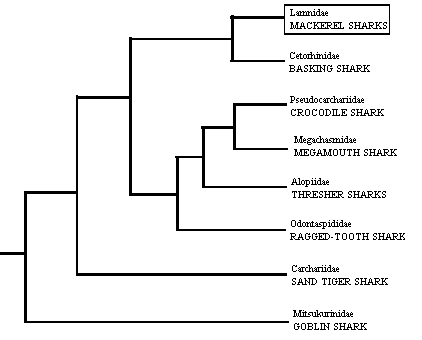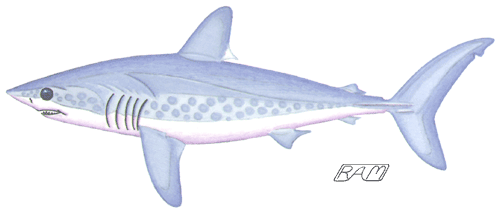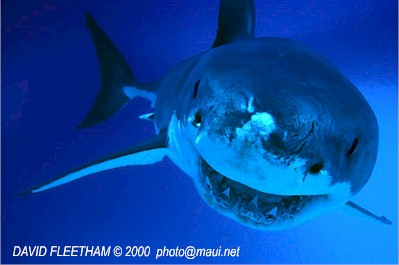Family Lamnidae:
Mackerel Sharks — 5 species

- gill openings large, barely extending onto the top of the head
- teeth enlarged, blade-like, and relatively few — less than 40 rows in each jaw
- gill rakers absent
- tail stalk slender, with precaudal pits and strong lateral keels
- caudal fin nearly symmetrical, with lower lobe almost as long as the upper
- coastal and oceanic; cool temperate to tropical zones of the Atlantic, Pacific, and Indian oceans

Porbeagle Shark (Lamna nasus)
The mackerel sharks are large active predators built on a common, highly specialized body plan. This body plan features: a solidly-built, fusiform body; a sharply-pointed, conical snout pocked with large, dark eyes; a large, crescentic mouth filled with relatively few but impressively large and conspicuous teeth; large gill slits, extending almost the depth of the throat; relatively tiny second dorsal and anal fins; a narrow tail stock (properly termed a caudal peduncle) supported by stout lateral keels; and a lunate (crescent moon-shaped) caudal fin. In addition, all lamnids — to a greater or lesser extent — feature a circulatory system modified to retain metabolic heat. This system consists of extensive networks of tightly-packed arterioles and veinules which carry blood countercurrent to one another, allowing heat from the venous blood (warmed by muscle contraction and other metabolic activity) to transfer efficiently to the cooler arterial blood (chilled by intimate contact with the marine environment during gas exchange at the gills), thereby conserving body heat. It is a wonderfully elegant arrangement, granting these sharks the speed, strength, and endurance benefits of warm-bloodedness without the accompanying high metabolic cost. The functional result of all this extensive external and internal engineering is a family of high-performance predatory 'machines', capable of sustained activity in even the coldest ocean waters.
 Intensely curious and highly
visual, the White Shark (Carcharodon carcharias) is
by far the most coastal of the lamnids. This habitat preference
sporadically brings it into contact with humans. Unfortunately, its
tendency to use its sensitive teeth and gums to explore novel objects has
sometimes resulted in serious injuries to swimmers, surfers, and divers.
Intensely curious and highly
visual, the White Shark (Carcharodon carcharias) is
by far the most coastal of the lamnids. This habitat preference
sporadically brings it into contact with humans. Unfortunately, its
tendency to use its sensitive teeth and gums to explore novel objects has
sometimes resulted in serious injuries to swimmers, surfers, and divers.
Photo © David Fleetham david@davidfleetham.com; used with the gracious permission of the photographer.
The family Lamnidae consists of the White Shark (Carcharodon carcharias), two species of mako, the Longfin (Isurus paucus) and the Shortfin (I. oxyrinchus), and two species of mackerel shark, the Porbeagle (Lamna nasus) and the Salmon Shark (L. ditropis). The many shared structural specializations of these sharks eloquently declares their common ancestry, and strongly implies a close relationship to their more laid-back grazing cousin, the Basking Shark (Cetorhinus maximus).
- More about the life history and behavior of the Salmon Shark
- More about the life history and behavior of the Porbeagle
- More about the life history and behavior of the White Shark
- More about the life history and behavior of the Longfin Mako
- More about the life history and behavior of the Shortfin Mako
